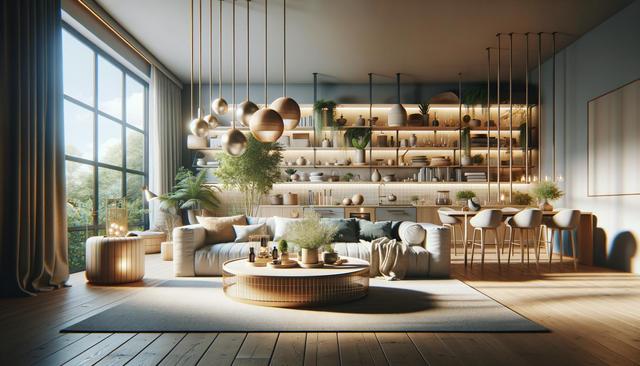
A Guide to Home Decor Trends In 2025
Embracing Organic Materials and Textures
In 2025, home decor continues to be heavily influenced by nature. Organic materials are becoming a staple in both furniture and architectural elements, offering not only visual warmth but also a tactile connection to the earth. Think of finishes such as reclaimed wood, clay, rattan, and natural stone—materials that bring an unrefined, yet elegant quality to interiors. Walls and floors are being reimagined with limewash paints and textural tiles that mimic the feel of raw surfaces.
Textiles are also leaning into the natural movement. Expect to see more wool, linen, cotton, and jute in upholstery, throws, and rugs. These materials not only look beautiful but also support a more sustainable lifestyle. The trend favors imperfections and handmade elements, reflecting a growing appreciation for craftsmanship.
Popular applications include:
- Woven light fixtures made from bamboo or seagrass
- Raw-edge wood shelves and countertops
- Handcrafted ceramic vases and dishware
This trend is perfect for creating calming, grounded spaces that feel both modern and timeless.
Smart Homes with Seamless Tech Integration
The home tech trend is evolving from flashy gadgets to subtle, integrated systems that enhance everyday living without disrupting aesthetics. In 2025, smart home features are being designed to blend invisibly into decor. From lighting and temperature control to voice-activated assistants and security systems, the emphasis is on seamless functionality.
Key innovations include:
- Smart mirrors with built-in lighting and weather updates
- Automated window treatments that adjust with daylight
- Hidden charging stations and wireless power surfaces
Designers are integrating technology into furniture and structural elements, such as coffee tables with built-in speakers or kitchen counters with embedded induction cooktops. The result is a living space that’s both intuitive and visually harmonious. Homeowners appreciate that they no longer have to choose between style and convenience—they can now have both.
Color Palettes Rooted in Nature
Color trends in 2025 are grounded in the natural world, offering a spectrum that evokes calm, clarity, and connection. Earthy tones like terracotta, olive green, and sand are returning, while deeper shades like forest green and navy are used to anchor rooms with a sense of stability. These hues promote a feeling of wellness and are often paired with soft neutrals like cream, taupe, and warm gray.
This year, accent colors are drawn from minerals and botanicals. Think dusty rose, amber, and ochre for accent walls, cushions, or decorative accessories. These colors are versatile and can shift the mood of a space depending on how they are combined.
Effective ways to incorporate these palettes include:
- Painting a feature wall in a clay-inspired hue
- Using textiles like curtains and cushions to layer tone
- Bringing in colored glassware and ceramics
By bringing the outside in through color, homeowners can create a sense of tranquility and balance that reflects the broader wellness movement influencing interior design.
Sustainable and Upcycled Design Choices
Sustainability is no longer a niche consideration—it’s at the forefront of home decor in 2025. Consumers are increasingly conscious of where their furnishings come from, how they’re made, and the environmental impact they leave behind. As a result, there’s a growing demand for pieces made from recycled, upcycled, or responsibly sourced materials.
Designers are responding with collections that tell a story. Furniture crafted from salvaged wood, repurposed metals, or recycled plastic is not only eco-friendly but also visually striking. Moreover, vintage and second-hand pieces are being embraced not just for their sustainability, but for their character and uniqueness.
Homeowners can make sustainable choices by:
- Choosing FSC-certified wood furniture
- Shopping locally for handmade or vintage decor
- Opting for modular pieces that can be repaired or updated over time
These sustainable practices allow for more mindful living and create interiors that are both beautiful and responsible.
Multifunctional Spaces and Flexible Layouts
With lifestyle shifts continuing to influence how we live at home, multifunctional spaces are more important than ever. Whether it’s working remotely, homeschooling, or simply needing more room for hobbies, 2025 home designs are embracing flexibility. Open-plan living is being refined with smart zoning, allowing one space to serve multiple purposes without feeling cluttered.
This trend is reflected in:
- Convertible furniture, such as sofa beds and foldable desks
- Room dividers that double as shelves or plant displays
- Built-in storage solutions that maximize small spaces
Designers are also focusing on acoustics and lighting to define different zones within a single room. From soft area rugs that absorb sound to pendant lights that highlight workspaces, every detail contributes to the functionality and comfort of a space.
By prioritizing adaptability, homeowners can future-proof their interiors, making them suitable for evolving needs over time.
Conclusion: Designing with Purpose in 2025
As we move through 2025, home decor is increasingly about thoughtful choices that reflect personal values and practical needs. From embracing sustainable design to integrating smart technology, the trends highlight a shift toward spaces that feel authentic, comfortable, and prepared for the future. Whether you’re updating a single room or rethinking your entire living environment, these trends offer inspiration for creating a home that’s both stylish and meaningful.


